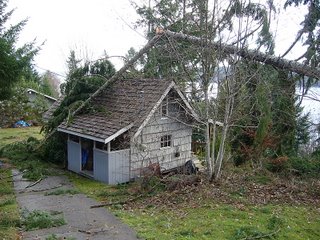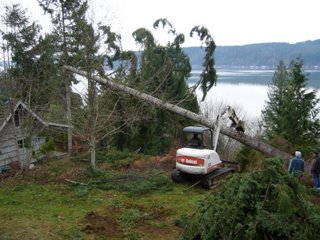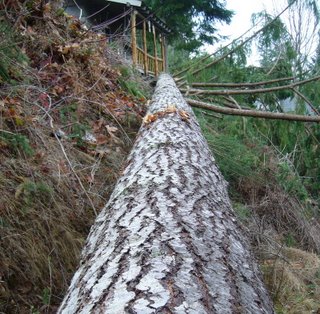You might have heard about the wind storm that punched the Northwest Thursday night. This followed a month of near-record rain in November. The wind and soggy ground meant that a lot of trees and power lines were damaged or fell over.
Tacoma report: We didn't lose power or cable TV or Internet access — one of the new neighborhoods able to say that. Our big fir tree in the front yard lost some limbs but we had no damage. That fir tree is going to become firewood this summer.
Cabin report: Our cabin, known as the Hut, near Tahuya was a different story. Lost power, but we expect that. We we didn't expect was that a tree fell
uphill and over the cabin. Amazingly and to our great benefit, the tree broke apart on the hillside as it fell and only a segment of the tree fell
across the cabin, not through it.

Some cedar shakes across the top of the roof were damaged and the wood stove chimney was knocked sideways. Fortunately, a neighbor who lives in the community full time and who was home and has a key to the Hut checked for damage. Nothing. No leaks. No holes in the roof. Lots of limbs are scattered all over the property and beyond but no Hut parts are scattered across the landscape. The bit that sticks out of the back of the hut, which we call the annex, holds the water heater — no damage. The front porch that overlooks Hood Canal — no damage. The power line from the transformer to the masthead — no damage.
Removing the tree carries some risk. It has to be done so that pieces of it don't fall on the Hut. The neighbor — a true neighbor in all of the best senses — has arranged for roofing materials, a roofer and a good tree guy. Then we'll call a chimney guy. Given all of the damage that others have suffered, we're pretty darned lucky.
 I have been knitting as much as usual recently, just not finishing. However, I did finish an Angel Pearls Beaded Scarf from Sivia Harding. The yarn is a stray skein from my stash: Lamb's Pride fingering weight in a color called Aran on US5 needles. The 6/0 beads, also from stash, are a color called "oil slick matte." Can't have too many scarves, right?
I have been knitting as much as usual recently, just not finishing. However, I did finish an Angel Pearls Beaded Scarf from Sivia Harding. The yarn is a stray skein from my stash: Lamb's Pride fingering weight in a color called Aran on US5 needles. The 6/0 beads, also from stash, are a color called "oil slick matte." Can't have too many scarves, right?










